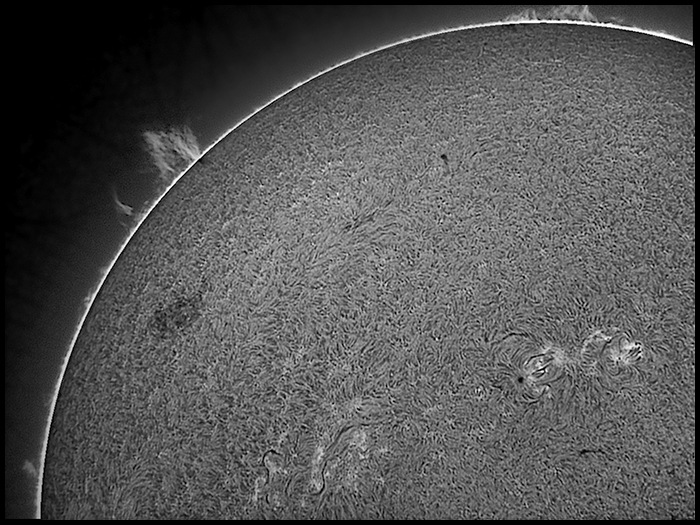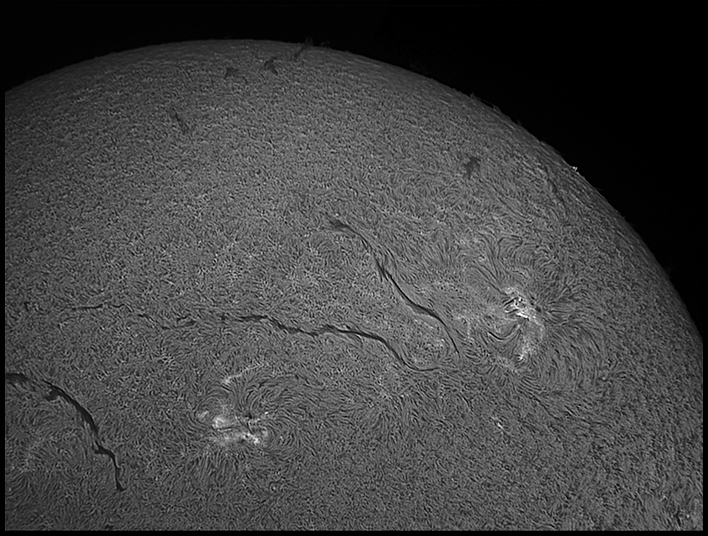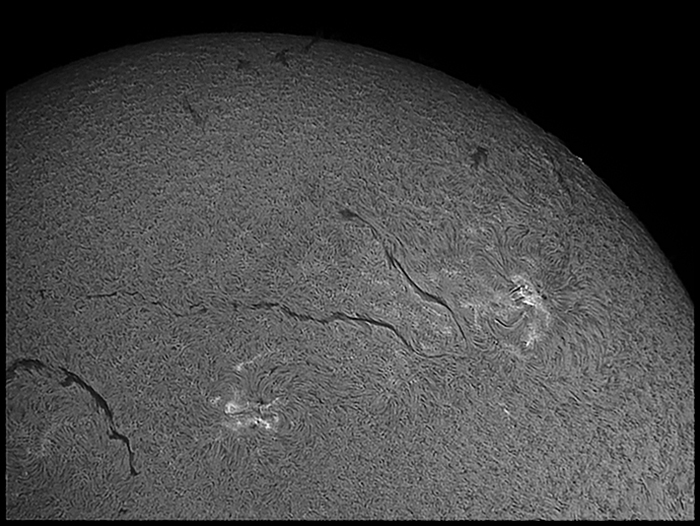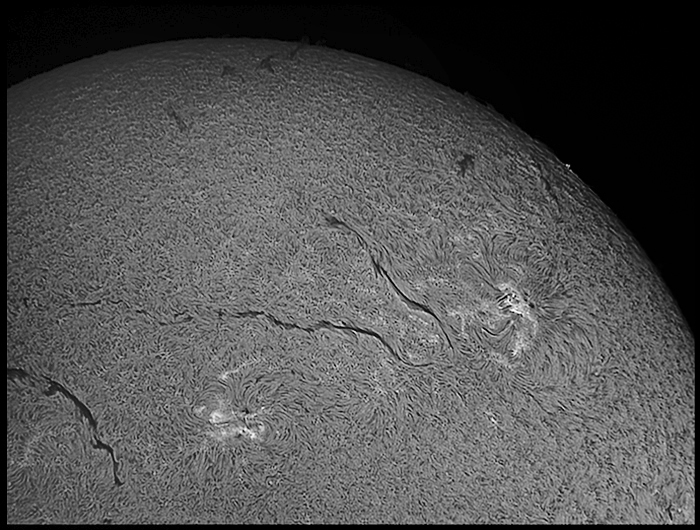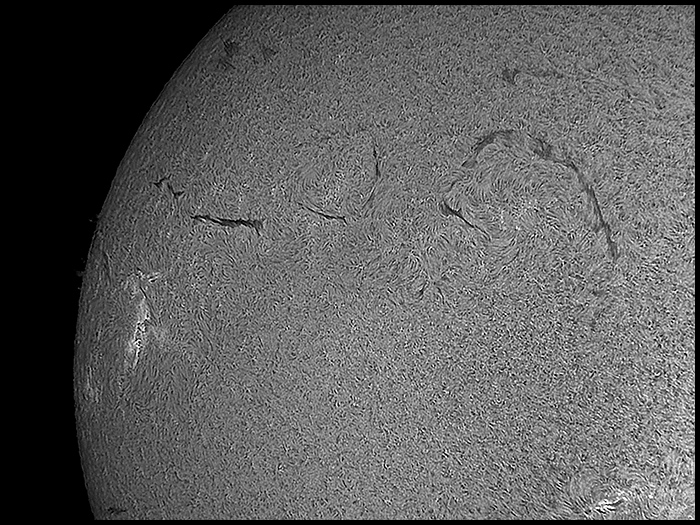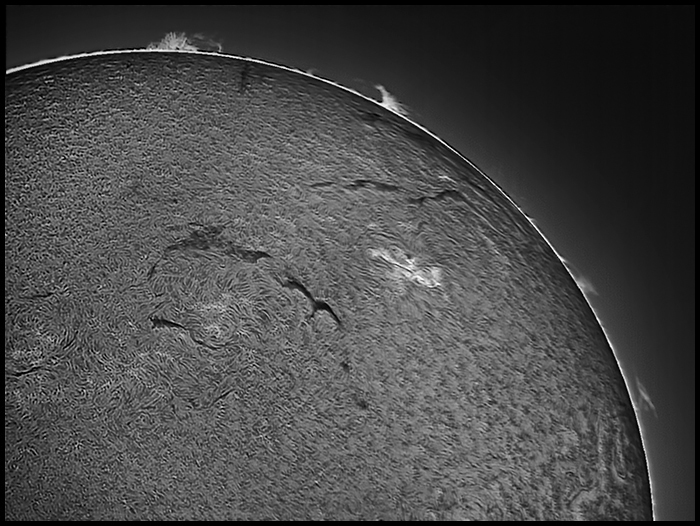|
While I get geared up to do some more informative comparisons, here's a 300 frame clip done the usual way, with buffered video acquired at 16fps:
300 x 9ms @ 16fps
Long-run video. I collected back to back 20-second (300 frame) buffered and 2-minute streaming clips of another part of the Sun to use for comparisons. Here's the best image I could pull from the first gig of the longer clip:
886 x 8ms @ 11.5 fps
Here's the best I can do with a 300-frame buffered capture of the same region:
VirtualDub does a fine job concatenating AVI's. The process goes like this: open the first file, select the final frame, open the second file; then select no audio and direct stream output for the video and save as a new AVI. Then process normally. Here's a 1,264-frame distillation made from a 2-minute capture which FlyCap broke into two AVI's:
The steps: First, acquire with Flycap I don't know that the differences will reproduce on the web at reduced scale as 8-bit JPEGs. The variations in large areas of brightness are due to individual applications of PS curves. The differences in the details and small-scale gradations are subtle. The image made from the full length video requires slightly less aggressive sharpening in "Focus Magic" and the result is clean enough to tolerate a modest "smart sharpen" pass. The 300 frame clip does not take that fiinal polish well at all -- edges become harsh and jagged -- though prior to that step the 300 frame and 1,264 frame images look quite similar. The image based on the longer clip can benefit from Focus Magic without the preliminary despeckle step (but is better with it and might be still better if I faded the despeckle step a bit prior to deconvolving with Focus Magic). 300 frames get the job done. Use more for showcase images when the Sun puts on some kind of special event. That's for today's conditions at this image scale. Maybe there's a place for longer captures. Work with them for a while and see. BTW, AVIStack took 22:52 (minutes:seconds) to process the full-length video and 5:09 for the 300-frame version. Make of that what you will. All in all, it's a good thing I caught a good sale on a "spare" 2TB drive at NewEgg yesterday. A gigabyte here, a gigabyte there, pretty soon your talking storage.
4/25/2012. Newegg got the drive to me today! I didn't ask for expedited anything and accepted the free shipping. Impressive. I haven't even figured out how best to use it. In early afternoon, the air was generally calmer than it was yesterday. I again selected "streaming" video capture and took four clips. In each case, I recorded at 13 fps and stopped when Flycap began a second file. I deleted the overruns and examined the 886-frame, 1 GB clips. I shot two clips of two regions and selected the steadier of each pair for processing. (Check to see if I can stream at full speed to the C: drive; the slower rates I thought were required may be related to the portable USB drive I sometimes use with the netbook. 4/27: yes, the Asprire One's C: drive will capture video at the Chameleon's top rate just north of 16 fps.)
886 x 5.6ms @ 13 fps
4/27/2012. See, it was cloudy all day and there was still a lot of high-altitude murk when I stubborned up and decided to see what I could do anyway. I had no idea any limb details at all would appear.
8ms x 5178
Stack over 5,000 frames and the dynamic range is superb, especially considering the lousy transparency. Not thrilled with the fine detail, which appears smeared here and doubled there. I concatenated five files and had to save as an "old" (18GB!) AVI before AVIStack would swallow the whole capture for processing (which took 1h38m). Registax kept insisting that there were only (!) 1,700 frames in the clip. The usual post-processing (wavelets in Registax, despeckle in Photoshop, deconvolution in FocusMagic, curves in Photoshop) followed, with seperate curves applied to the limb and the disk. You know, just another snapshot. [It struck me overnight: five 1GB clips is something like 4,300 frames, so apparently one clip managed to get added in twice.] The lesson of this page: stacking and processing can work wonders, but steady air matters much.
|
:: top ::
© 2011, David Cortner
